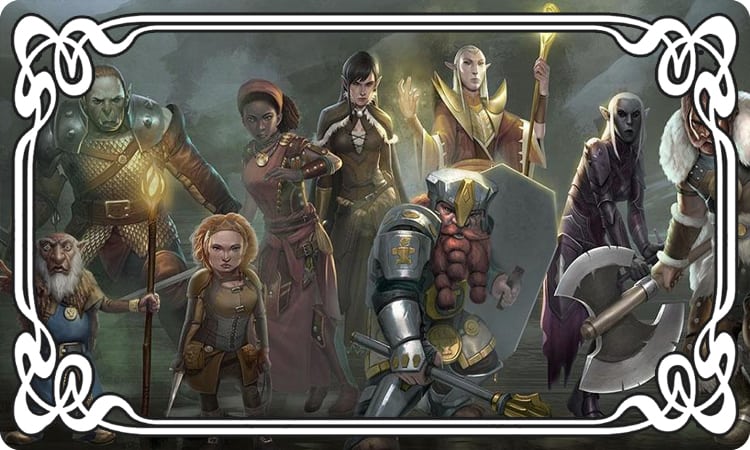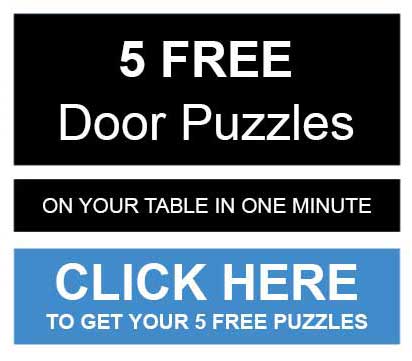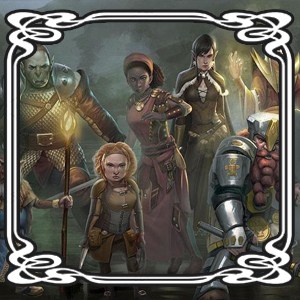
Managing a large group of players can be daunting, but I’ve run several campaign with groups as large as twelve players without a hitch. And I’d like to share what I’ve learned. So how do I manage large D&D groups?
You can manage a large group of D&D players by setting clear expectations for every segment of the game. Clearly explain what you expect from players during each segment and what they can expect from you. And then, meet those expectations.
Of course, setting expectations and meeting them requires a bit of practice. But hopefully, these tips will make managing large groups a breeze.
1. Make Time to Chat Before You Start
During any game at some point, players will want to talk about different topics. Maybe it’s the latest star wars movie, or what happened at work the other day. When you have more players at the table those interruptions add up. So one way of dealing with them is taking some time to chat before the game starts.
You can, for instance, explain that the game starts in fifteen minutes. So now is players chance to talk about different stuff. When you start ask players to table stuff that isn’t about the story until after the session (or until you take a break). Also, ask them to keep their phones of the gaming table.
2. Serve the Story!
99 out of a 100 problems in D&D can be solved by asking one simple question: Does it serve the story? When you are running a game it is not about the DM and not about any one player. It’s about creating a great story together.
Tell your players that whenever they want to do something both in character and out of character, they should first ask themselves: Does it serve the story?
Are players talking to each other while the DM gives a description? That doesn’t serve the story. Is their character hugging the spotlight so a shyer player can’t get a word in edgewise? Not serving the story either. Find our tips for DMing shy players here.
When you invite players to actively think about the needs of the whole group, most problems fall away. And the DM doesn’t have to ‘manage’ disruptive behavior as much. Also, when you ask players if their behavior serves the story, they don’t take it as personally. After all, you’re not asking for yourself, but for the whole group. This is where having a larger group can actually work in your favor!
In time your group will become more self-managing so you can focus on keeping the story going.

3. Get Their Attention
When two people are talking to each other in a large group they often start talking louder just to hear each other. Of course, this causes other players to start talking louder as well, creating an escalation of sound volume.
A second thing that happens is that our brain tries to pick up the voice of one person while trying to block the sound of other peoples voices. This can make it really difficult for a DM to get their attention.
The solution? Get a small bell. The sound of a bell cuts through conversations. It is also not a sound players where actively trying to ignore. Are players still talking? Get a bigger bell!
4. Say What You Will Do and Why
The best way to set expectations is by telling players what you will do and why. For instance: Instead of interrupting a player, say: “I’m going to interrupt you for a moment to keep the story going.”
Or you could say: “Okay, This is going to be a massive combat, so make sure you are ready when it’s your turn to speed things up.”
Telling players what you expect and what to expect helps them achieve the right mindset immediately. Often it seems like players in large groups seem disruptive when they actually just had a different expectation of that segment of the game.
For instance, if players expect that a segment is all about discussing a solution with other players, and the DM suddenly start giving a description out of the blue, they won’t listen.
Social interaction, combat, and exploration each require a slightly different mindset. And telling players what to expect will help them make those transitions faster. (Of course, the party still decides how to handle encounters).


5. Prepare Your Descriptions
In large groups, the time windows where you have everyone’s undivided attention are smaller. So when you do have their attention, be ready to speak your bit.
I always try to have at least the first sentence of what I want to say ready in my mind before I get the players’ attention. That way, I can start speaking right away.
I also try not to beat around the bush. Start giving your description immediately. Use body language, gestures, voices, whatever to keep their attention.
A good description only takes one or two minutes. There is a lot you can convey when you come prepared.
I usually try to finish my descriptions with a question. This lets the players know it’s their turn to talk. If you use this method often, they’ll also learn that it isn’t their turn to talk yet, when you haven’t asked a question yet.
6. Give Players the Spotlight
This one is super important. Create segments at regular intervals where it is just the players doing all the talking. Preferable with each other. This way, players can spend more time in character, and they spend less time waiting on others. And for the DM it’s an opportunity to just sit back and maybe prepare the next story segment.
A good way to let players do all the talking is giving open-ended tasks. An open-ended task requires creative planning. It’s a task that can be accomplished in many different ways. For example, an open-ended task could be: Manipulate two kingdoms into starting a war.
With open-ended tasks, the DM doesn’t have to come up with a complex scheme that players must uncover. Instead, the players become the schemers. They’ll spend a lot of time actively coming up with plans.
Most elaborate plans involve multiple steps. Once those steps are clear, you can suggest players break up into smaller groups to each discuss the details of a step. This saves time and allows more players to have their say. And the less time players have to spend waiting on each other, the better. I also like to spring multiple challenges on players at the same time. So maybe a puzzle, a dam that is about to break, and an army of orcs attacking. The players will each choose the task they most like to solve. And the great thing about premade puzzles is that they cost almost no time to DM, freeing up your time to focus on the other challenges.
7. Involve Everyone at the Table
A downside of giving players the spotlight is that some players are louder than others. It can be hard for shy players to make themselves heard in a larger group. If that’s the case. You can assign different tasks to couples so everyone automatically has a conversation with another player.
Creating couples in character can also be a great idea. Sometimes having the character of a louder or more experienced player, be best friends with the character of a shy player helps.
Asking a specific player questions, also helps move the spotlight on them. Another method (stolen from family therapy) is ‘circular questioning’. If a player asks the DM a question that another player might be able to answer, refer the player to his party member. For instance:
Emma: “This sword, is that quality metal?”
DM: (Asks another player) “Brunor, you’re a dwarf. What do you say?”
Jeff: “Looks fine to me. And I know me metals.”
Redirecting questions to other players is a great way of getting them to interact more. And in large groups, I like my players to do most of the talking.
Also think about the type of challenges you want to present players with. Combat is turn based. Everyone has to wait their turn and that gets old quickly. But when you introduce a puzzle or riddle every player at the table can get involved simultaneously. My favourite puzzles in our webshop for large groups are Rune Puzzles and Lock Puzzles. For riddles I recommend the Deck of 101 Riddles.
Related Article:

8. Combat: Ask Players to be Prepared for Their Turn
Sometimes players just have to wait their turn. That’s especially true during combat. Ask every player to prepare and have their action ready, when it’s their turn. Place new players next to experienced ones at the table so they can quietly ask for help. Also making the initiative clearly visible for everyone really helps players know when it is their turn, especially in large groups.
Alternatively, you can have all players roll for initiative. The player with the highest initiative goes first, then the player on his left and so on. The upside of this method is that players don’t have to look to a chart to see who’s turn it is. And it is much more easy to see when the person sitting next to you finishes a turn, than having to keep an eye on the person sitting furthest away.
9. Delegate
Delegating works great in large groups. You can have players:
- Keep notes.
- Draw out dungeon rooms as you describe them.
- Keep track of loot.
- Look up rules.
- Refill your drink (kidding).
Give players who have a hard time waiting extra responsibilities. If you have a player in your group who also DMs, you can even ask that player to temporarily DM a part of the group. Having two DMs usually works best when the group splits up to accomplish different tasks. Of course, the second DM would have to agree to give up being a player for a short while.
10. Don’t Let Rules Slow Down the Game
In large groups, you want to keep things going. Long discussions about rules can grind the game to a halt. If there is a discussion there is usually one outcome that favors the character(s) and one that does not. To speed things up, you can invoke the rule of fifty-fifty.
With the rule of fifty-fifty, players flip a coin to see if things go their way or not. Game rules don’t always matter when Lady Luck has her say.
I also use this rule a lot when there is a gray area not covered in the rule. For instance, does a character take full damage if he falls onto a sloped surface? Physics say he shouldn’t. Rules as written say he does. Why not let Lady Luck decide and move on?
Related Questions
How Do You Deal With a D&D Group That Has Grown Too Big?
You can deal with a D&D group that has grown too big by either creating two groups, asking if anyone was considering leaving anyway, or using the West Marches system, where the combination of players that make up the party changes every session.
Of course, it’s usually best to just put the question to the players. That way you share in the responsibility. But the best way of not having to size down your party is not letting it grow too big in the first place.
What is the Average D&D Party Size?
The average D&D party size consists of five players. The 5e edition DM guide p.83 states that 3-5 players is the ideal party size. Most Wizards of the Coast adventures are geared toward 4-5 players. So actual party sizes are slightly larger than the suggested ideal party size.
By Paul Camp



